...
Functional Requirement
Requirements Design
- New Policy API support - Partial commit ( Resource commitment pending)
Non-Functional Requirement
- PNF/xNF Authentication (Pending commitment based on Nokia's contribution)
Platform Maturity
Platform Maturity (i.e., S3P items) https://wiki.onap.org/display/DW/Dublin+Release+Platform+Maturity
Green color → Target level ( details see Platform Maturity below)
- Performance: Level 1
- Stability: Level 1+ (80% coverage cannot be met overall due to number of components; will be phased and approached for Dublin)
- Resiliency: Level 2
- Security: Level 1+
- Scalability: Level 1
- Manageability: Level 2 (STRETCH GOAL)
- Usability: Level 2 (STRETCH GOAL)
Minimum Viable Product
...
Anyone reading this section should have a good understanding of all the interacting modules.

Refering to CII Badging Security Program and Platform Maturity Requirements, fill out the table below by indicating the actual level , the targeted level for the current release and the evidences on how you plan to achieve the targeted level.
| Area | Actual Level | Targeted Level for current Release | How, Evidences | Comments |
|---|
| Performance | 1 | 1+ (Dublin recommendation 2 - cannot be committed due to Resource constraint) |
| - Level 0: no performance testing done
- Level 1: baseline performance criteria identified and measured (such as response time, transaction/message rate, latency, footprint, etc. to be defined on per component)
- Level 2: performance improvement plan created
- Level 3: performance improvement plan implemented for 1 release (improvement measured for equivalent functionality & equivalent hardware)
|
| Stability | 2 | 1+ (Dublin recommendation 2 - may not reach 80% code coverage due to number of repository in DCAE; will be phased and some component targeted for R4) |
| - Level 0: none beyond release requirements
- Level 1: 72 hour component-level soak test (random test transactions with 80% code coverage; steady load)
- Level 2: 72 hour platform-level soak test (random test transactions with 80% code coverage; steady load)
- Level 3: track record over 6 months of reduced defect rate
|
| Resiliency | 2 | 2 |
| - 0 – none
- 1 – manual failure and recovery (< 30 minutes)
- 2 – automated detection and recovery (single site)
- 3 – automated detection and recovery (geo redundancy)
|
| Security | 1 | 1+ (Dublin recommendation 2 - cannot be committed for following reason)
- Resource constraint
- CADI library not available for Python
- Process of AAF certificate distribution in K8S between ONAP components and external (xNF) to be defined
DCAE team will integrate with Buscontroller integration for dynamic topic provisioning and AAF based role setting as STRETCH GOAL
|
| - Level 0: None
- Level 1: CII Passing badge
- Including no critical and high known vulnerabilities > 60 days old
- Level 2: CII Silver badge, plus:
- All internal/external system communications shall be able to be encrypted.
- All internal/external service calls shall have common role-based access control and authorization using CADI framework.
- Level 3: CII Gold badge
|
| Scalability | 1 | 1
|
| - Level 0: no ability to scale
- Level 1: supports single site horizontal scale out and scale in, independent of other components
- Level 2: supports geographic scaling, independent of other components
- Level 3: support scaling (interoperability) across multiple ONAP instances
|
| Manageability | 1 | 2 (STRETCH GOAL- based on resource availability)
|
| - Level 1:
- All ONAP components will use a single logging system.
- Instantiation of a simple ONAP system should be accomplished in <1 hour with a minimal footprint
- Level 2:
- A component can be independently upgraded without impacting operation interacting components
- Component configuration to be externalized in a common fashion across ONAP projects
- All application logging to adhere to ONAP Application Logging Specification v1.2
- Implement guidelines for a minimal container footprint
- Level 3
- Transaction tracing across components
|
| Usability | 1 | 2 (STRETCH GOAL- based on resource availability)
|
| - Level 1:
- User guide created
- Deployment documentation
- API documentation
- Adherence to coding guidelines
- Level 2:
- Level 3
- Consistent UI across ONAP projects
- Usability testing conducted
- API Documentation
- Level 4
|
...
